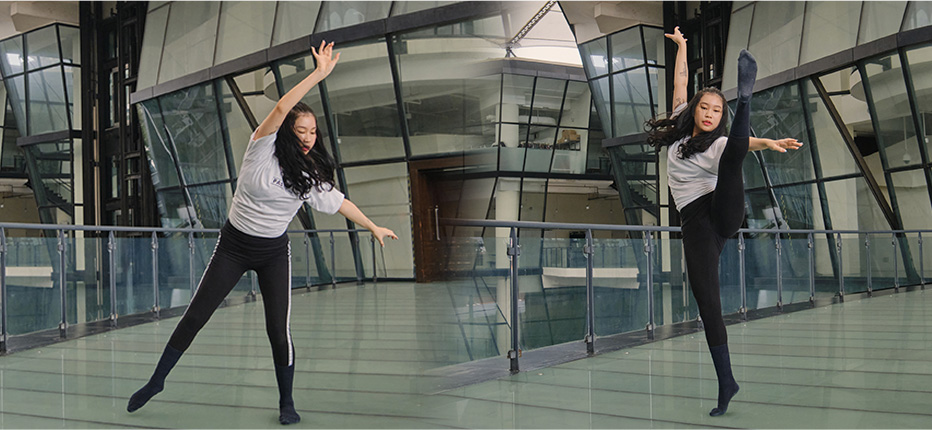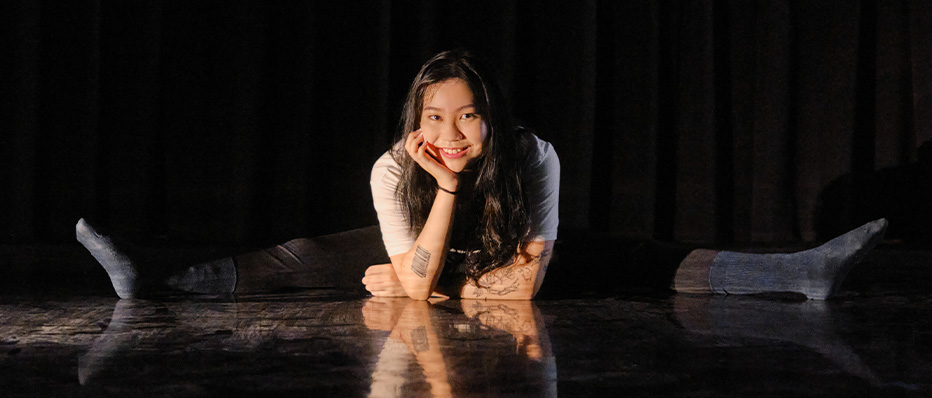Chelsea Lim pursued a Diploma in Dance at the Lasalle College of the Arts as her journey is rooted in her passion for this powerful medium of expression.
Struggles with Specific Language Impairment
While growing up, Chelsea struggled with an undiagnosed and rare condition, Specific Language Impairment, that affected her reading and writing. Her impairment was not with speech but she found it challenging to concentrate on passages she read, re-reading them multiple times to understand them fully. Writing proved to be a frustrating exercise as well, as Chelsea could not recall how to spell certain words or accurately articulate her thoughts on paper.

Chelsea's dance journey
Chelsea's mum enrolled her in dance class since she was three but it was when she was struggling in school that she found that in dance, she could express herself and her feelings through a range of movements. It was easier to “talk through my movements” than through speech or writing. She has a preference for jazz and tap dancing which comprised simple and less structured steps than ballet but put together, the result could be an amazing expressive dance. She also realised that dance was a critical source of stress relief and helped her release the pressures she faced at school dealing with her disability.
Chelsea joined a dance studio, Jazz Cats, after her “O” levels. Starting with simpler tasks that included hair and make-up for the students, she grew to teach her own class and now has a range of students from 5 - 15 years of age. She credits her development to a really good and understanding boss who gave her the freedom to conduct her classes. Although the job can be mentally and physically exhausting, her reward is seen in how the young dancers develop into better dancers.
At Lasalle, Chelsea had the opportunity to choreograph her own pieces and performances. She drew inspiration from many people and styles, particularly, K-Pop. For her final presentation in Year 2, Chelsea chose to write about Mrs Jean Chan, who taught her dance when she was at the Singapore Chinese Girls’ Primary School, and who played an influential role in her dance journey. Though her solo presentation took time and patience to develop, Chelsea performed well and was very happy with the final results.
Dance will be Chelsea's future
Chelsea is keen to spend her post-Lasalle journey choreographing and teaching dance to young students. She hopes to watch them grow and develop into passionate and confident dancers, just as she had.
July 2022
DISCOVER HER ACHIEVEMENTS HER CONDITION
Achievements
"Bandages" is a performance by Chelsea Lim that was a collaboration between dance and film at Lasalle College of the Arts.
Unable to see, unable to notice. Focus. What can you feel? What can you hear? Being deprived of your sight is not a disadvantage. Heighten your other senses, find what you are looking for.
It is a piece representing the future. Going in blind. You can’t predict the future but you can learn from the past. Focusing on what I have instead of what I lost, I do my best to find my way through the dark world we live in. Will I be able to survive? Or will I fall and lose everything?
DEVELOPMENTAL LANGUAGE DISORDER
Developmental Language Disorder (DLD), previously known as Specific Language Impairment, is a communication disorder that interferes with the development of language skills in children and affects a child’s listening (receptive language) and speech (expressive language) abilities as well as reading and writing. It can affect children who do not have hearing loss or intellectual disabilities. It usually persists into adulthood. DLD can also be present with emotional or behavioral disorders, such as attention-deficit/hyperactivity disorder (ADHD) or anxiety. While children with developmental disabilities, including autism spectrum disorder, may also have difficulties with speech and language, DLD is not necessarily associated with Autism.
Symptoms
A child with DLD often has a history of being a late talker and reaches spoken language
milestones later than peers.
Preschool-aged children with DLD may have the following characteristics:
- Struggle to learn new words and make conversation
- Be late to put words together into sentences
- Face difficulty following directions because they do not fully understand the words spoken to them
- Make frequent grammatical errors when speaking
Although some late talkers eventually catch up with peers, children with DLD have persistent language difficulties. Symptoms common in older children and adults with DLD include:
- Limited use of complex sentences
- Difficulty finding the right words
- Difficulty understanding figurative language
- Reading problems
- Disorganized storytelling and writing
- Frequent grammatical and spelling errors
Causes
The cause for DLD is unknown but studies have revealed that there is a genetic link. While learning more than one language at a time does not cause DLD, the disorder can affect a child's ability to learn one or more languages.
TreatmentIdeally, recognising the condition pre-school and early intervention can result in better outcomes. Speech and language therapy has been recommended as the most effective intervention strategy with therapists working with parents and caregivers and providing teachers with supportive strategies to help the child to cope.
Meanwhile, the following are useful tips for parents and caregivers to use:
- Make eye contact with the child during conversations
- Use visual cues, actions and materials as much as possible
- Use short, simple sentences and enumerate instructions if several steps are involved
- Give the child time to process and observe if they have understood, repeating instructions as needed
- Rephrase the instructions if the child appears unclear
- Let the child have time to find words to use in responding, prompting them as necessary with choices (not too many) they can choose from
- Offer prompts rather than ask questions, for e.g., instead of asking “What did you eat for snack?”, ask “Did you have fruit of biscuits for snack?”
- As questions can be intimidating for a child with DLD, make a comment rather than use a question whenever possible.
- Instead of correcting an error in speech, respond with the correct form. For e.g., “I come from the swimming pool” - respond with “Yes, you came from the swimming”.
- Add words gradually to form complete sentences. For e.g., “Max hungry eat lunch” - respond with “Max is hungry. Time for lunch ”.
- Develop langauge and conversation rich opportunitites to keep communication going

